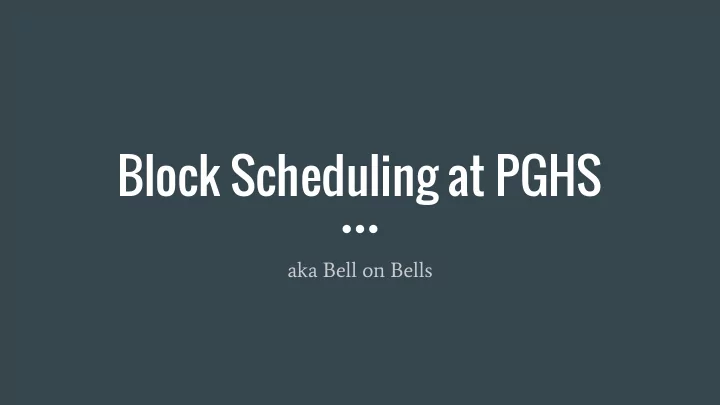

Block Scheduling at PGHS aka Bell on Bells
Block Scheduling Used to Improve the Following: Dropout rates Grade retention reduction Standardized testing results SAT/ACT/AP results
Assumptions - Longer periods will deepen instruction - Additional time gained will allow more subject coverage - Student attention span and learning capacity is the same for minutes 1-50 as it is for minutes 51-105 - Student outcomes will improve when allowed to focus on four classes per day - Teaching will improve with faculty able to focus on fewer classes per day
Recent Research Studies by Dr. Paul King (Texas Christian Univ.) have shown that information ● can be compared to weight lifting for the brain. The more you pile on, the harder it is to recall. Students who were given a single class of 3 hours once a week retained less information than students who had 3 50-minute classes per week. Students were asked to listen to information equivalent to a lecture (my interpretation.) Dr. Michael Rettig (James Madison Univ.) concluded in his studies on block ● scheduling that “overwhelming evidence bolsters the view that a school environment can be affected positively [by a block schedule]. Sufficient data shows that students’ academic performance is not harmed and many individual schools...have reported increases in student performance.” Furthermore, “a school schedule can have an enormous impact on the a school’s instructional climate.”
Texas Research on Block Scheduling in High Schools The State of Texas conducted research on all high schools in the state with respect to block schedules in their high schools. Findings include: 1. School context (school size, student body characteristics, staff characteristics) is much more closely related to overall student performance than the particular types of schedules high schools used. 2. When contextual factors are removed, school schedules do not account for the variations in student performance. 3. With contextual factors included, the strongest predictor of high student performance is the efficacy students and teachers engage in the teaching-learning process.
PGHS Faculty and Student input from 2015 survey Faculty: Faculty chose current block configuration by approximately 60% Percentages varied with respect to 4 block days v. 2 block days Students: Students favored block scheduling 94.8% to 5.2% 82.4% favored 4 block days v. 12.4% favoring 2 block days
Application for PGHS PGHS dropout rates, retention rates, standardized test results, and SAT/ACT/AP ● results have improved over time and compare favorably with all metrics. As Dr. Rettig suggests that school climate can be significantly affected by the ● schedule, and as the Texas study concluded that the schedule isolated by other factors could not account for differences in student performance, the driving factor in deciding a schedule should be the positive climate impact. Synthesizing the research by Dr. King with other research, it seems logical to ● assume that using a single teaching methodology such as lecture negates any benefits of a longer class period and could have a detrimental effect on learning.
So Where does PGHS go from here? 1. Focus PGHS professional development on implementing research-based teaching methodologies that prevent “brain fatigue” and learning degradation noted by Dr. King such as differentiated instruction, frequent instructional pauses to allow student reflection and discussion, and changes in activities during the class period. 2. Pursue refinement of the Professional Learning Community tenets of data collection, analysis, research and action by faculty to drive systemic change. 3. Foster empowerment of faculty, administration and staff to make changes based on what is best for students and to support those changes to the highest degree possible. (ILT’s, staff-driven Prof. Dev., site-based monetary decision) 4. Continued surveys of educational community w/respect to schedule.
Recommend
More recommend